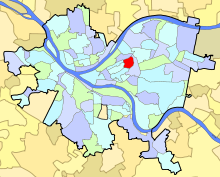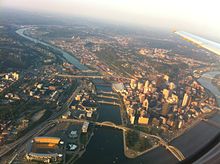- Hill District
-
The Hill District is a collection of neighborhoods that is considered by many to be the cultural center of African-American life in Pittsburgh, Pennsylvania, an American city. Harlem Renaissance poet Claude McKay once called the district "the crossroads of the world," referring to the neighborhood's heyday in the 1930s–1950s. It is known to many Pittsburghers as simply "The Hill."
It is bordered by the Downtown on the west, the Strip District and Polish Hill on the north, the Bluff (Uptown) on the southwest, and Oakland on the east and southeast.
The Hill District was the setting for nine out the plays in August Wilson's 10-play Pittsburgh Cycle.[1]
Contents
Neighborhoods
Bedford Dwellings 
Neighborhood in Pittsburgh, PennsylvaniaPopulation (1990): 2317[2] Population (2000): 2109[2] Area: 0.179 sq mi (0.46 km2)[2] Upper Hill 
Neighborhood in Pittsburgh, PennsylvaniaPopulation (1990): 2590[2] Population (2000): 2246[2] Area: 0.313 sq mi (0.81 km2)[2] The Hill District comprises five distinct neighborhoods. A recent new development near Downtown is Crawford Square. The neighborhoods are represented on the Pittsburgh City Council by the council member for District 6 (Downtown neighborhoods), and part of the Upper Hill is also represented under District 7. The 15219 ZIP code covers all five neighborhoods, and the 15213 ZIP code covers part of Terrace Village and the Upper Hill.
- Crawford-Roberts
- Upper Hill
- Middle Hill
- Bedford Dwellings
- Terrace Village
Demographics and history
About 40 percent of the Hill District's residents live below poverty level, and the vast majority of residents are black or African American; about 6 percent of the population is white.[3]
Many residents view a major turning point in the neighborhood's history as the 1960s, when the city of Pittsburgh displaced about 8000 residents and 400 businesses in the Lower Hill to build the Civic Arena.[4] Recent initiatives have aimed to revitalize the area, which has struggled for decades with varying levels of dilapidation and crime.[5]
A project to open a new grocery store—the neighborhood has lacked one for 30 years—is expected to come to fruition in the next few years. The YMCA is building a $9 million branch in the neighborhood, complete with a rooftop garden. A group of investors have gathered to restore the New Granada Theater, a historic jazz club where Ella Fitzgerald and Duke Ellington once performed.[5] And Duquesne University, a nearby college, plans to open a new pharmacy for residents in the neighborhood by the end of 2010.[6]
Trivia
The TV Show Hill Street Blues ties its name origin back to the Hill District. Steven Bochco, a series writer for the show, attended college at the nearby Carnegie Institute of Technology (now Carnegie Mellon University) and based the show on the neighborhood. 2002 NYT
From the 1960s to 1982 the Pirates' Hall of famer Willie Stargell owned a fried chicken store on the Hill. Patrons would receive free chicken if they were in the store at the time Stargell hit a home run. Pirates' radio announcer Bob Prince coined the phrase "Spread some chicken on the Hill with Will."
See also
References
- ^ Weber, Bruce. "Israel Hicks, Director of August Wilson’s Cycle, Dies at 66", The New York Times, July 7, 2010. Accessed July 8, 2010.
- ^ a b c d e f Census: Pittsburgh. Pittsburgh Department of City Planning. January 2006. http://www.city.pittsburgh.pa.us/cp/assets/census/2000_census_pgh_jan06.pdf. Retrieved 2007-07-19.
- ^ "Commemorating a century of service, today's Boy Scouts reach out to Minorities," Pittsburgh Post-Gazette, July 22, 2010, accessed Dec. 9, 2010 url: http://www.post-gazette.com/pg/10203/1074228-55.stm
- ^ Trotter, Joe W. & Day, Jared N. "Race and Renaissance: African-Americans in Pittsburgh Since World War II."
- ^ a b Nereim, Vivian (January 4, 2010). "Frazier departs Hill House at 'tipping point'". Pittsburgh Post-Gazette. http://www.post-gazette.com/pg/10004/1025555-53.stm?cmpid=localstate.xml.
- ^ Nereim, Vivian (April 23, 2010). "Hill District residents rejoice over drugstore". Pittsburgh Post-Gazette. http://www.post-gazette.com/pg/10113/1052680-114.stm.
Further reading
- Toker, Franklin (1994) [1986]. Pittsburgh: An Urban Portrait. Pittsburgh: University of Pittsburgh Press. ISBN 0-8229-5434-6.
External links
 Media related to Hill District at Wikimedia Commons
Media related to Hill District at Wikimedia Commons- Carnegie Library's History of The Hill
- City of Pittsburgh's Hill District page
- Wylie Avenue Days Program log - Documents the Hill District's best years through the 1930s-1950s
Categories:- Neighborhoods in Pittsburgh, Pennsylvania
- Populated places in Pennsylvania with African American majority populations
Wikimedia Foundation. 2010.

